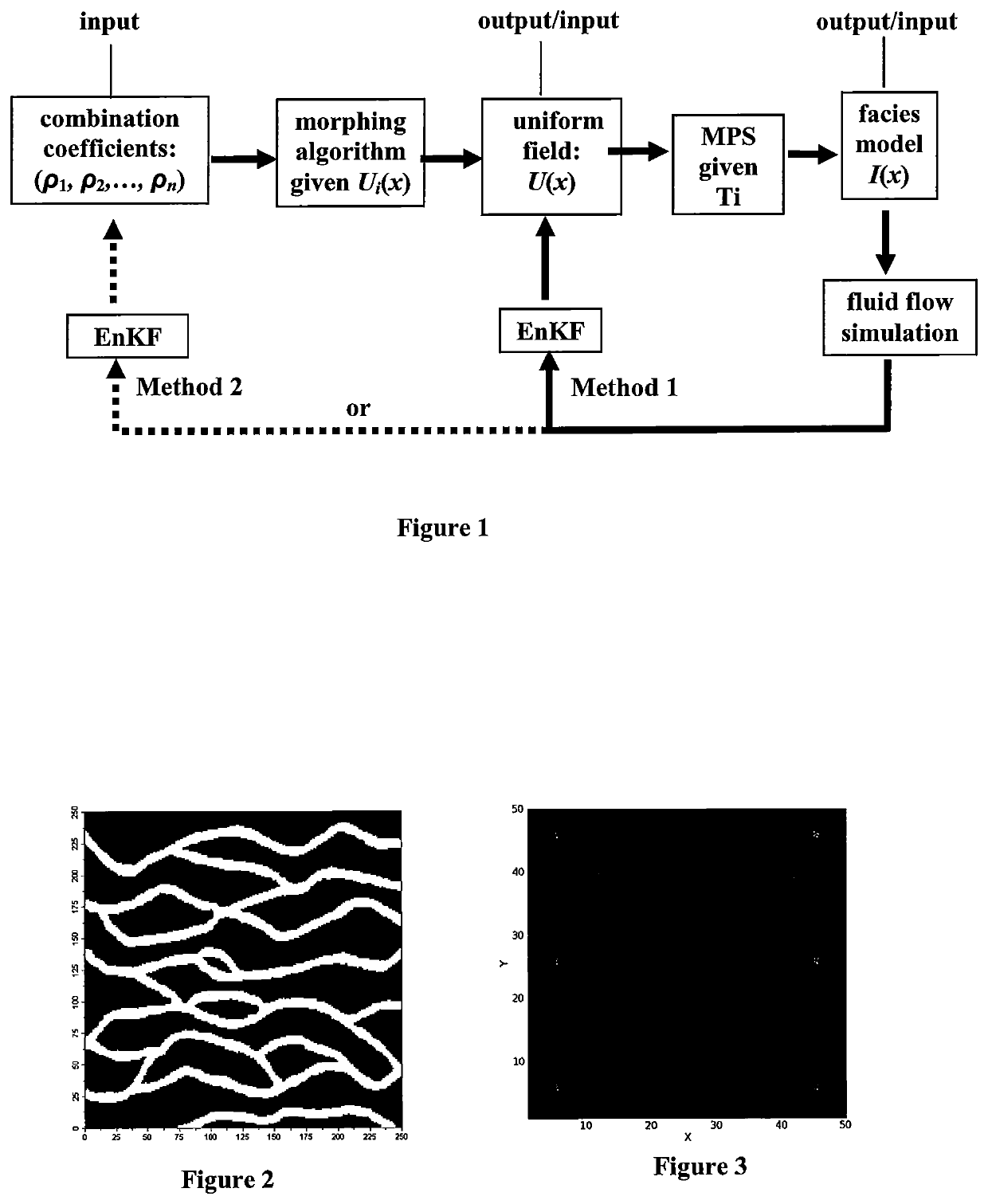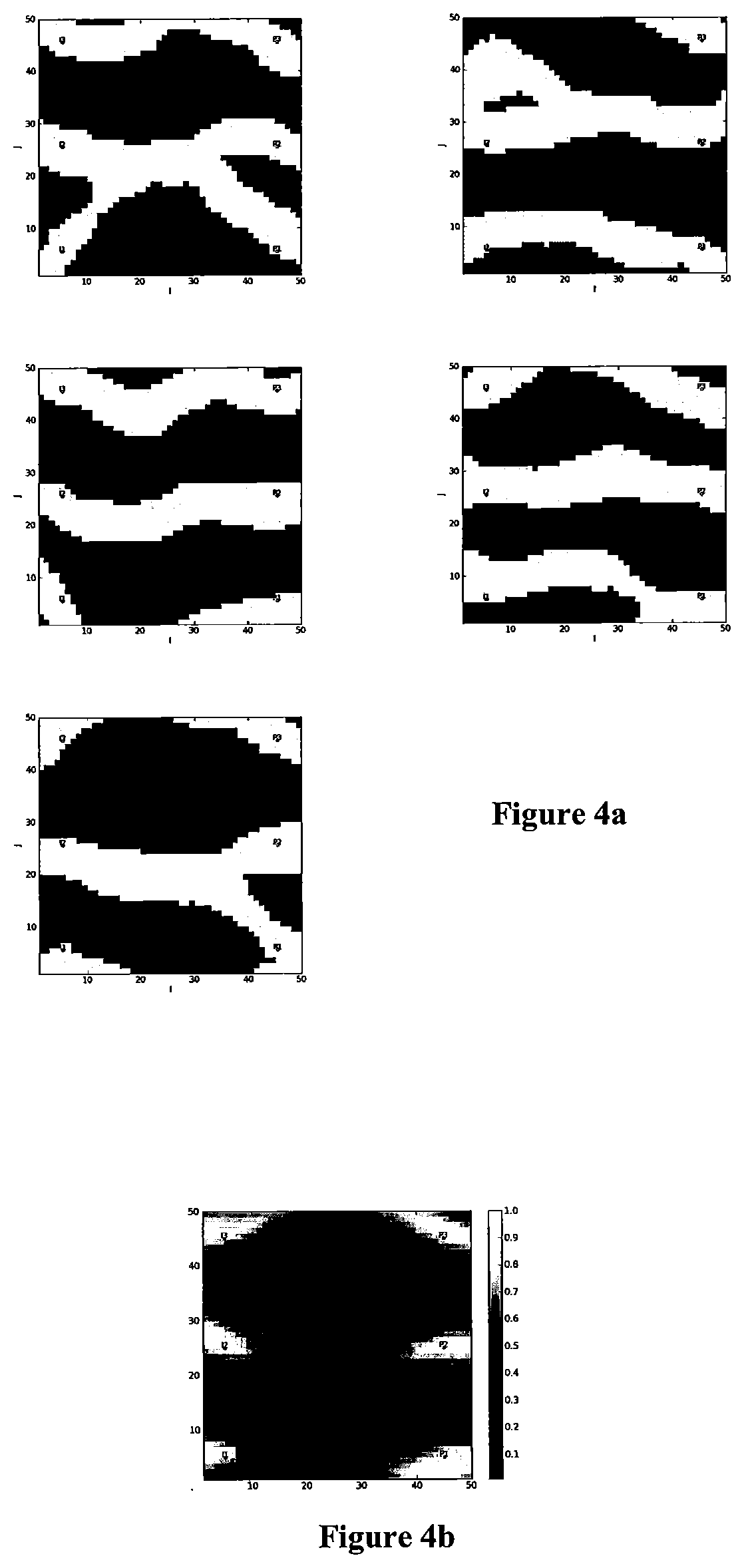Updating geological facies models using the Ensemble Kalman filter
a technology of ensemble kalman filter and geological facies, applied in the field of updating geostatistical hydrocarbon reservoir models, can solve the problems of enkf becoming less efficient, affecting the efficiency of enkf, and the degree of uncertainty that needs to be accounted
- Summary
- Abstract
- Description
- Claims
- Application Information
AI Technical Summary
Benefits of technology
Problems solved by technology
Method used
Image
Examples
example 1
[0058]Consider first using the EnKF approach to update a uniform vector directly. The procedure is as follows:
[0059]Initiation:
1. Set t=0 for the initial time step;
2. Generate an initial ensemble of n uniform vectors: Uit, i=1, 2, . . . , n;
3. For all uniform vectors Uit, compute their corresponding standard Gaussian vectors using the inverse standard Gaussian cumulative distribution function (Gaussian score transformation):
Yit=G−1(Uit),i=1,2, . . . ,n;
[0060]Iteration:
4. Build the reservoir model mit for each Uit by the predefined geostatistical simulation procedure (e.g. MPS) with Uit as input and mit as output;
5. Perform flow simulation for each mit between time steps 0 and t+1;
6. Update the ensemble of Gaussian vectors {Yit, i=1, 2, . . . , n} using EnKF from time step t to time step t+1: {Yit+1, i=1, 2, . . . , n};
7. For all the updated Gaussian vectors Yit+1, compute their corresponding uniform vectors (uniform score transformation):
[0061]Uit+1=G(Yit+1σit+1),i=1,2,…,n;
8. Set ...
example 2
[0065]Consider now using the EnKF approach to update the combination coefficients of a set of uniform vectors. This method involves a relatively small number of parameters (combination coefficients), in comparison with the number of grid nodes of the geomodel. The procedure is as follows:
[0066]Initiation:
1. Generate n uniform vectors: Ui, i=1, 2, . . . , n;
2. Set t=0 for the initial time step;
3. Generate an initial ensemble of k uniform vectors ρl,1t=(ρl,1t, ρl,2t, . . . , ρl,nt; l=1, 2, . . . , k; all components of these vectors are uniform numbers between −2 and 2;
4. For all vectors ρlt, compute their corresponding standard Gaussian vectors:
Ylt=(Yl,1t,Yl,2t, . . . ,Yl,nt),l=1,2, . . . ,k, with Yl,it=G−1(0.5+0.25ρl,it),i=1,2, . . . ,n;
[0067]Iteration:
5. For each vector of combination coefficients ρlt=(ρl,1t, ρl,2t, . . . , ρl,nt), perform the linear combination:
[0068]∑i=1ntg(πρl,it4)Ui,
then compute its corresponding uniform vector Ult by the uniform score transformation;
6. Bu...
example 3
[0070]A small scale (50×50) test model was created with multiple point simulation using the freely avaialble SNESIM software from Stanford University. The model was based on a training image (250×250) which is typical of a facies channel reservoir (see FIG. 2) and the parameters for the model were in typical ranges.
[0071]A first random realization was generated which, for the purposes of the test, was considered to represent a real reservoir. This realization is called the target realization and the objective of the test was to demonstrate that the method according to the invention can be used to assimilate simulated dynamic data from the target realization in a history matching process. The target realization is represented in FIG. 3.
[0072]An ensemble of 100 initial random realizations, each based on the model, was then generated. Five of these are represented in FIG. 4a, together with a so called channel probability map (FIG. 4b), which is a graphic representation of the probabili...
PUM
 Login to View More
Login to View More Abstract
Description
Claims
Application Information
 Login to View More
Login to View More - R&D
- Intellectual Property
- Life Sciences
- Materials
- Tech Scout
- Unparalleled Data Quality
- Higher Quality Content
- 60% Fewer Hallucinations
Browse by: Latest US Patents, China's latest patents, Technical Efficacy Thesaurus, Application Domain, Technology Topic, Popular Technical Reports.
© 2025 PatSnap. All rights reserved.Legal|Privacy policy|Modern Slavery Act Transparency Statement|Sitemap|About US| Contact US: help@patsnap.com



